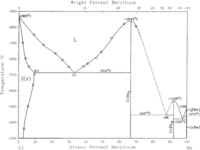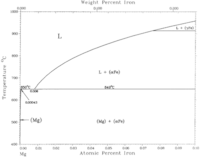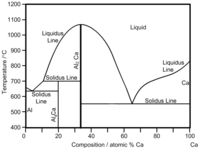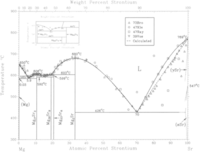Minerals/Metals/Alkaline earths
< Minerals < MetalsThe alkaline earth metals are the elements in Group 2 of the Periodic Table: beryllium (Be), magnesium (Mg), calcium (Ca), strontium (Sr), barium (Ba), and radium (Ra).
Berylliums

Beryllium occurs in a hexgonal close-packed (hcp) crystal structure at room temperature (α-Be).
As indicated in the phase diagram on the left beryllium occurs as (β-Be) which is bcc at higher temperatures up to melting.
Native beryllium is not known to occur on the surface of the Earth, but may eventually be found among beryllium-bearing minerals in small amounts.
Bromellites
Bromellite is BeO, with 50 at % beryllium.[1]
Magnesiums

Magnesium has a hcp structure from room temperature up to melting. No other phases occur as is shown in the magnesium-end of the iron-magnesium phase diagram on the left.
Native magnesium is unlikely to occur on the surface of the Earth and is not known to occur.
Chloromagnesites
Chloromagnesite, or chlormagnesite, has the formula MgCl2, with 33.3 at % magnesium.[1]
Forsterites
Mg2SiO4 is the formula for forsterite, with 28.6 at % magnesium.[1]
Forsterite is a member of the olivine group of minerals.[1]
Calciums

Calcium has a face-centered cubic (fcc) crystal structure at room temperature.
As shown in the phase diagram on the left, it does not change structure up to melting.
Native calcium is not known to occur on the surface of the Earth.
Fluorites
Fluorite has the formula CaF2 with 33.3 at % calcium.[1] Fluorites are also halogen minerals.
Bredigites
Bredigite is α-Ca2SiO4, with 28.5 at % calcium.[1]
γ-dicalcium silicates
γ-dicalcium silicate has the formula γ-Ca2SiO4, with 28.5 at % calcium.[1]
Strontiums

Strontium at room temperature crystallizes in a fcc structure (α-Sr).
According to the phase diagram on the left, α-Sr transforms to γ-Sr (bcc) at 547°C.
Native strontium does not appear to occur on the surface of the Earth.
Bariums
.png)
Barium is bcc (α-Ba) at room temperature as the phase diagram on the left indicates. It does change to an hcp structure at high pressures and temperatures.
Native barium is not known to occur on the surface of the Earth.
Radiums
"Solid radium is bcc at room temperature. Radium melts at 973 K.63"[2]
Research
Hypothesis:
- Native alkaline earths may require very arid and reducing environments to occur.
Control groups

The findings demonstrate a statistically systematic change from the status quo or the control group.
“In the design of experiments, treatments [or special properties or characteristics] are applied to [or observed in] experimental units in the treatment group(s).[3] In comparative experiments, members of the complementary group, the control group, receive either no treatment or a standard treatment.[4]"[5]
Proof of concept
Def. a “short and/or incomplete realization of a certain method or idea to demonstrate its feasibility"[6] is called a proof of concept.
Def. evidence that demonstrates that a concept is possible is called proof of concept.
The proof-of-concept structure consists of
- background,
- procedures,
- findings, and
- interpretation.[7]
See also
References
- 1 2 3 4 5 6 7 Willard Lincoln Roberts, George Robert Rapp, Jr., and Julius Weber (1974). Encyclopedia of Minerals. 450 West 33rd Street, New York, New York 10001 USA: Van Nostrand Reinhold Company. pp. 693. ISBN 0-442-26820-3.
- ↑ David A. Young (11 September 1975). Phase Diagrams of the Elements. University of California, Livermore, California USA: Lawrence Livermore Laboratory. pp. 70. http://www.iaea.org/inis/collection/NCLCollectionStore/_Public/07/255/7255152.pdf. Retrieved 2015-08-26.
- ↑ Klaus Hinkelmann, Oscar Kempthorne (2008). Design and Analysis of Experiments, Volume I: Introduction to Experimental Design (2nd ed.). Wiley. ISBN 978-0-471-72756-9. http://books.google.com/?id=T3wWj2kVYZgC&printsec=frontcover.
- ↑ R. A. Bailey (2008). Design of comparative experiments. Cambridge University Press. ISBN 978-0-521-68357-9. http://www.cambridge.org/uk/catalogue/catalogue.asp?isbn=9780521683579.
- ↑ "Treatment and control groups, In: Wikipedia". San Francisco, California: Wikimedia Foundation, Inc. May 18, 2012. Retrieved 2012-05-31.
- ↑ "proof of concept, In: Wiktionary". San Francisco, California: Wikimedia Foundation, Inc. November 10, 2012. Retrieved 2013-01-13.
- ↑ Ginger Lehrman and Ian B Hogue, Sarah Palmer, Cheryl Jennings, Celsa A Spina, Ann Wiegand, Alan L Landay, Robert W Coombs, Douglas D Richman, John W Mellors, John M Coffin, Ronald J Bosch, David M Margolis (August 13, 2005). "Depletion of latent HIV-1 infection in vivo: a proof-of-concept study". Lancet 366 (9485): 549-55. doi:10.1016/S0140-6736(05)67098-5. http://www.ncbi.nlm.nih.gov/pmc/articles/PMC1894952/. Retrieved 2012-05-09.
External links
![]() This is a research project at http://en.wikiversity.org
This is a research project at http://en.wikiversity.org
| |
Development status: this resource is experimental in nature. |
| |
Educational level: this is a research resource. |
| |
Resource type: this resource is an article. |
| |
Resource type: this resource contains a lecture or lecture notes. |
| |
Subject classification: this is a Geology resource. |